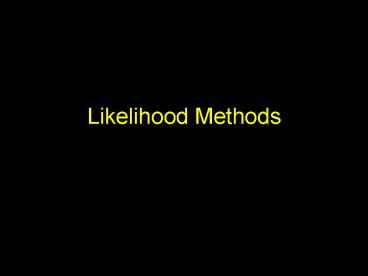Likelihood Methods - PowerPoint PPT Presentation
1 / 17
Title:
Likelihood Methods
Description:
Likelihood Methods. Likelihood maximization is a very common ... Try P = 0.8. L(D) = 0.8 * 0.8 * 0.2 = 0.128 ... Tries out many nested models of ... – PowerPoint PPT presentation
Number of Views:97
Avg rating:3.0/5.0
Title: Likelihood Methods
1
Likelihood Methods
2
Likelihood maximization is a very common approach
to inference
3
A coin is known to be biased The coin is tossed
three times two heads and one tail Use
principal of ML to estimate the probability of
throwing a head
Try P 0.2
L(D) 0.2 0.2 0.8 0.032
Try P 0.4
L(D) 0.4 0.4 0.6 0.096
Likelihood of the Data
Try P 0.6
L(D) 0.6 0.6 0.4 0.144
Try P 0.8
L(D) 0.8 0.8 0.2 0.128
Probability of a head
4
Genetic Distance
Given a model of the way sequences evolve we can
derive a function that describes the likelihood
of observing a particular pair of sequences as a
function of the inferred genetic distance between
them
5
A C G G A G Consider simplified Jukes and Cantor
model
D 0.3 0.3 0.3 0.7 0.063
D 0.6 0.6 0.6 0.4 0.144
Likelihood
D 0.9 0.9 0.9 0.1 0.081
Note this is a major simplification
Distance
6
Genetic Distance using Maximum Likelihood
- Require a model of evolution
- Optimise all parameters of the model
- Each evolutionary event has an associated
likelihood given an inferred genetic distance - The likelihood of the sequence-pair is a function
of the genetic distance (just the product of the
likelihoods of each of the inferred events at
each sequence position) - Function is minimized
7
Phylogenetic trees using Maximum Likelihood
- Require a model of evolution
- Each substitution has an associated likelihood
given a branch of a certain length - A function is derived to represent the likelihood
of the data given the tree, branch-lengths and
additional parameters - Optimise over parameters of the model
- Optimise over branch lengths
- Sum the likelihood over all possible sequences at
ancestral nodes - Search for the best tree (using heuristics such
as TBR)
8
Models can be made more parameter rich to
increase their realism
- The most common additional parameters are
- A correction to allow different rates for each
type of nucleotide change - A correction for the proportion of sites which
are unable to change - A correction for variable rates at those sites
which can change - The values of the additional parameters will be
estimated in the process
9
A gamma distribution can be used to model site
rate heterogeneity
Can be iterative.
- Rates of evolution can be worked out accurately
if the tree is known - Accurate rates of evolution for each sequence
position improve the accuracy of the tree
Rates programme
Rates
Tree
Tree programme
10
Likelihood and the number of parameters
- More parameters always leads to a better fit of
the data
11
More parameters always leads to a higher value of
the likelihood whether or not the additional
parameters are providing a significantly better
fit to the data
12
- Are the extra parameters justified?
- - Likelihood ratio test (applies to nested
models) - - Akaike Information Criterion
dof number of additional parameters
13
One model is nested in another if it is a special
case of the more general model e.g. the Jukes
and Cantor model and Kimura 2P model
14
- Modeltest
- - Uses PAUP
- - Tries out many nested models of nucleotide
substitution - - Decides how many parameters are justified by
the data
GTR does not overfit the data for at least some
HIV sequences
15
Likelihood-based tests of topologies
- Kishino-Hasegawa test
- Trees specified apriori
- KH can be used to test whether two competing
hypotheses have significantly different
likelihood - Involves non-parametric bootstrap to get an idea
of by how much the likelihoods vary - NB should not be used to test trees that have
been chosen on the basis of the data!
16
Likelihood-based tests of topologies
- Shimodaira-Hasegawa test
- Can be used to test confidence of ML tree
compared to related trees (e.g. second most
likely tree from the data) - PAUP, Andrew Rambaut http//evolve.zoo.ox.ac.uk/so
ftware/shtests
17
Inferring Sequences at Ancestral Nodes
- Maximum likelihood estimates of tree topologies
also provide inferred sequences at ancestral
nodes - Analysis of sequences at ancestral nodes and
sequence changes at ancestral branches can
provide information about the timing of the
acquiring of a novel trait or mutation - PAML (Phylogenetic Analysis using Maximum
Likelihood) - Confidence intervals provided
- Selection can be inferred































